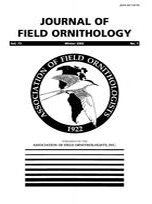This paper evaluates the effectiveness of the area search method to measure breeding landbird populations at the plot level. During June 1999, 10 plots in grassland and shelterbelt habitats of north-central South Dakota were surveyed three times using the area search method. The results were then compared with those simultaneously obtained by the spot mapping census method, which served as the standard for comparison. Area searches detected an average of 96.0% of the landbird species present on the grassland plots, and 84.2% of the species on the shelterbelt plots. Species accumulation curves were identical between techniques, suggesting that an increase in number of visits to each plot would likely increase the number of species detected during area search surveys. Estimates of territory density from spot mapping were available for five passerine species. Across all species, area searches underestimated territory densities by an average of 50% when visit data were summarized by taking the average. When data were summarized using the maximum value among visits to each plot, area searches underestimated territory density by an average of 26%. Precision of density estimates using area search was similar between summarization methods, and was generally lower in comparison to spot mapping. Across all species, area search and spot mapping density estimates were strongly associated, suggesting that area search has potential as an index to abundance. However, correlation coefficients in abundance varied considerably within individual species. Since area search surveys typically underestimated both species richness and density of territories, further experimentation with increased survey duration is warranted.
BioOne.org will be down briefly for maintenance on 14 May 2025 between 18:00-22:00 Pacific Time US. We apologize for any inconvenience.
How to translate text using browser tools
1 July 2002
A field test of the area search method for measuring breeding bird populations
J. Scott Dieni,
Stephanie L. Jones
ACCESS THE FULL ARTICLE
It is not available for individual sale.
This article is only available to subscribers.
It is not available for individual sale.
It is not available for individual sale.

Journal of Field Ornithology
Vol. 73 • No. 3
July 2002
Vol. 73 • No. 3
July 2002
abundance
grasslands
landbirds
richness
shelterbelts
South Dakota
spot mapping




